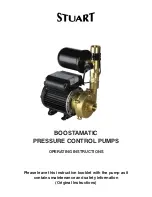
EN-6
452234.66.73 · FD 9910
www.gdts.one
English
SIH 90TU
7.2 Connection on the heating side
ATTENTION!
!!
Flush the heating system prior to connecting the heat pump.
Before connecting the heating water system to the heat pump,
the heating system must be flushed to remove any impurities,
residue from sealants, etc. Any accumulation of deposits in the
liquifier could cause the heat pump to completely break down.
Once the heat pump has been connected to the heating sys-
tem, it must be filled, de-aerated and pressure-tested.
The following points must be observed when filling the system:
Untreated filling water and make-up water must be of
drinking water quality
(colourless, clear, free of sediments)
Filling water and make-up water must be pre-filtered (max.
pore size 5 µm).
Scale formation in domestic hot water heating systems cannot
be avoided, but in systems with flow temperatures below 60 °C,
the problem can be disregarded. With high-temperature heat
pumps and in particular with bivalent systems in the higher per-
formance range (heat pump + boiler combination), flow tem-
peratures of 60 °C and more can be achieved. The following
standard values should therefore be adhered to with regard to
the filling and make-up water according to VDI 2035, sheet 1:
The total hardness values can be found in the table.
Fig. 7.1:Guideline values for filling and make-up water in accordance with
VDI 2035
For systems with an above-average specific system volume of
50 l/kW, VDI 2035 recommends using fully demineralized
water and a pH stabiliser to minimize the risk of corrosion in the
heat pump and the heating system.
ATTENTION!
!!
With fully demineralized water, it is important to ensure that
the minimum permissible pH value of 7.5 (minimum
permissible value for copper) is complied with. Failure to
comply with this value can result in the heat pump being
destroyed.
Minimum heating water flow rate
The minimum heating water flow rate through the heat pump
must be assured in all operating states of the heating system.
This can be accomplished, for example, by installing a dual dif-
ferential pressureless manifold.
The frost protection function of the heat pump manager is ac-
tive whenever the heat pump manager and the heat circulating
pumps are ready for operation. The system must be drained if
the heat pump is taken out of service or in the event of a power
failure. If heat pump systems are implemented in buildings
where a power failure cannot be detected (holiday homes etc.),
the heating circuit should be operated with suitable frost pro-
tection.
7.3 Heat source connection
The following procedure must be observed when making the
connection:
Connect the brine pipe to the heat source flow and return of the
heat pump.
The hydraulic integration diagram must be adhered to.
ATTENTION!
!!
The supplied dirt trap must be inserted in the heat source inlet
of the heat pump to protect the evaporator against the ingress
of impurities.
The brine must be produced prior to charging the system. The
brine concentration must be at least 25 %. This guarantees
frost protection up to approx. -14 °C.
Only monoethylene glycol or propylene glycol-based antifreeze
may be used.
The heat source system must be de-aerated and checked for
leaks.
ATTENTION!
!!
The brine must contain at least a 25 % concentration of a
monoethylene glycol or propylene glycol-based antifreeze,
which must be mixed before filling.
ATTENTION!
!!
A suitable de-aerator (micro bubble air separator) must be
installed in theheat source circuit by the customer.
7.4 Temperature sensor
The following temperature sensors are already installed or must
be installed additionally:
Outside temperature sensor (R1) supplied (NTC-2)
Return temperature heating circuit (R2) installed (NTC-10)
Return temperature primary circuit (R24) installed (NTC-
10)
Flow temperature heating circuit (R9) installed (NTC-10)
Flow temperature primary circuit (R6) installed (NTC-10)
Total heat
output in kW
Total alkaline earths
in mol/m³ and/or
mmol/l
Specific system volume
(VDI 2035) in l/kW
< 20
20 < 50
50
Total hardness in °dH
< 50
2.0
16.8
11.2
< 0.11
50 - 200
2.0
11.2
8.4
200 - 600
1.5
8.4
< 0.11
> 600
< 0.02
< 0.11
1
1. This value lies outside the permissible value for heat exchangers in heat
pumps.
















































